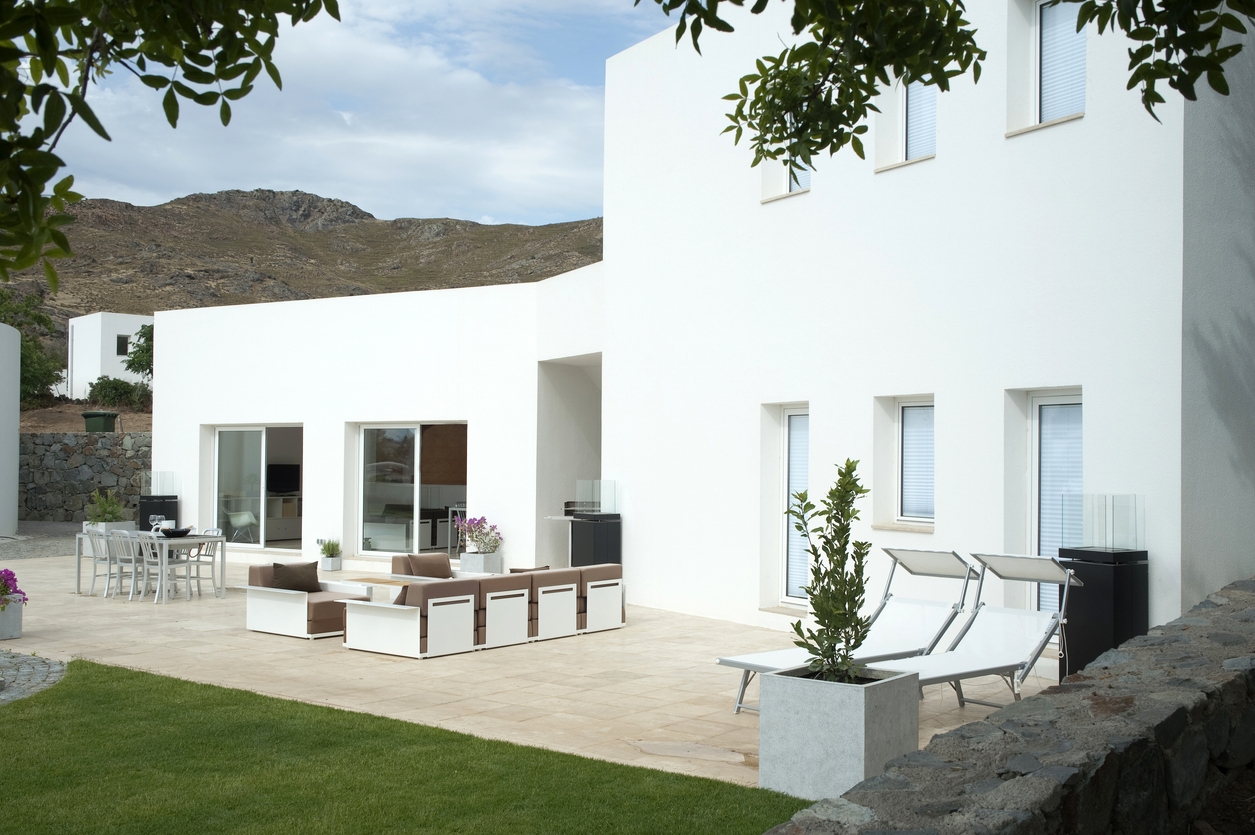Many owners of traditional and modern Concord homes prefer their homes painted in classic white – and for good reasons. White exteriors’ appeal is timeless. They offer a classic, clean, and versatile look that suits various architectural styles. Homeowners often consider painting their houses white to achieve a fresh, modern appearance, enhance curb appeal, or create a neutral backdrop that complements other design elements.
Benefits of a white exterior
A white exterior offers several benefits for a home, both aesthetic and practical:
- Enhanced curb appeal and modern aesthetic: White is a classic and timeless color that instantly boosts curb appeal, giving a Benicia, CA home a clean, contemporary, and sophisticated look. It can make the house stand out in a neighborhood and create an unforgettable first impression.
- Perception of cleanliness and freshness: White evokes a sense of purity, cleanliness, and freshness. It reflects light well, making the exterior look bright and inviting. This perception of cleanliness can enhance the overall appeal of the property.
- Versatility with various architectural styles: White is highly versatile and complements various architectural styles, from traditional to contemporary. Whether paired with natural materials like stone and wood or modern finishes like metal and glass, white provides a neutral backdrop that allows other design elements to shine.
- Energy efficiency: White reflects sunlight, helping to keep your Antioch, CA home cooler in warmer climates. It can lead to energy savings by reducing the need for air conditioning.
Considerations before choosing white
When considering white for your exterior, here are some key factors to keep in mind:
- Impact on energy efficiency (heat reflection): White reflects sunlight more effectively than darker colors, which can help keep your home cooler in warm climates. It can improve your Lafayette, CA area home’s energy efficiency by reducing your need for air conditioning. However, white may not be ideal in colder climates as it won’t absorb as much heat during winter.
- Need for regular maintenance: White exteriors tend to show dirt, stains, and discoloration more effortlessly than darker colors, meaning you’ll likely need to clean your exterior more frequently to maintain its pristine appearance. Regular maintenance, such as power washing or touch-up painting, may be necessary to keep it looking fresh. You also need to take maintenance into consideration if you have to paint vinyl or aluminum siding.
- Potential for showing dirt and imperfections: White surfaces can highlight imperfections like cracks, chips, and dirt buildup, making them more noticeable. It could result in more frequent repairs or touch-ups to keep the exterior looking well-maintained.
Choosing white for your exterior can offer a timeless, clean look, but it requires careful consideration of maintenance and climate-related factors.
Choosing the right shade of white
Choosing the right shade of white for your home’s exterior can be surprisingly complex. Here’s a breakdown of key considerations:
Understanding the differences between cool and warm whites
Cool whites:
- Undertones: Cool whites have undertones of blue, green, or gray. These tones can give your Pleasant Hill, CA home a crisp, clean, and modern look.
- Best suited for: Homes with modern or contemporary architecture or in settings with lush greenery or a cooler climate, as they contrast nicely against natural surroundings.
- Impact: Cool whites can enhance the sleek lines of modern design and work well with other cool colors like gray, black, or navy.
Warm Whites:
- Undertones: Warm whites contain undertones of yellow, beige, or pink, which can create a softer, more inviting appearance.
- Best suited for: Homes with traditional, rustic, or Mediterranean architecture or in areas with a lot of sunlight, where the warm tones make the house appear more welcoming.
- Impact: Warm whites are often perceived as inviting and pair well with warm materials like wood, brick, or terra cotta.
Tips for selecting the best white shade
Consider the architectural style:
- For modern Walnut Creek, CA area homes, cool whites can enhance a minimalist aesthetic.
- Traditional or historic homes might benefit more from warm whites complementing natural materials.
Assess the surroundings:
- Take note of your landscape, neighboring homes, and the natural environment. A cool white might stand out against greenery, while a warm white can blend harmoniously with earthy tones.
- Think about the direction your home faces. In cooler, shadier areas, warm whites can bring a sense of warmth. In sunny areas, cool whites can reflect light and keep a Vallejo, CA home looking bright without becoming overly warm.
Test under different lighting conditions:
- Light can significantly alter the perception of color. It’s essential to test your chosen white in different lighting conditions—morning, afternoon, and evening.
- Consider how the color looks in direct sunlight versus in the shade. A color that appears perfect in the store might look entirely different on a large scale outside.
Complementing other features:
- Pay attention to the color of your roof, windows, doors, and other exterior elements. A warm white can look better with a terracotta roof, while a cool white might pair well with a slate or metal roof.
- Look at the trim and accent colors. If you have dark trim, a cool white might provide a stark contrast, while a warm white can create a more blended look.
Take inspiration from local architecture:
- Look around your neighborhood for inspiration. White is a common choice for many homes, but the specific shade that works best can depend on local trends, materials, and climate.
Consider longevity and maintenance:
- White can show dirt and wear more easily than other colors, so consider the maintenance involved. Cooler whites might be slightly more forgiving in showing less dirt than warmer, creamier shades.
- Consider how your choice of white shade will age over time. Some whites might develop a slight patina, changing in appearance as the years pass.
Understand these factors and carefully test different shades. They will help you choose a white that enhances your home’s exterior, reflects your style, and complements your surroundings.
Practical tips for painting your home white
When complementing white with accent colors on trim, doors, and shutters, you can create a striking and personalized exterior look for your home. Here are some ideas:
Accent colors
- Trim: Light gray or soft beige can subtly enhance the architectural details without overwhelming the clean look of white.
- Doors: Bold colors like deep navy blue, classic red, or forest green make a strong statement and add personality to the entrance.
- Shutters: Charcoal gray, muted blue, or earthy browns can add depth and contrast to the white exterior, drawing attention to windows and adding visual interest.
Enhancing with landscaping and exterior elements
- Landscaping: Use plants and flowers that complement your accent colors. For example, if you choose navy blue for the door, plant hydrangeas with blue or white blossoms. Greenery like boxwoods and evergreens add lush contrast against white.
- Other exterior elements: Incorporate matching or complementary colors in your outdoor furniture, lighting fixtures, or even in your choice of pavers and walkway materials. For instance, a natural stone walkway with tones that echo the color of your shutters can tie the whole look together.
Combining these elements can create a cohesive, inviting, and visually appealing exterior.
Practical tips for painting your house white
Preparation steps for painting the exterior
- Surface cleaning: Begin by thoroughly cleaning the exterior surfaces to remove dirt, mildew, and peeling paint. Use a pressure washer or a hose with a scrub brush and cleaning solution to ensure a clean surface.
- Repair and patch: Inspect the exterior for cracks, holes, or damaged areas. Repair these using exterior-grade fillers, caulks, or wood putty. Sand the repairs smoothly to ensure an even surface.
- Priming: Apply a high-quality exterior primer, especially if you paint over a darker color or the surface is porous. Primer helps the paint adhere better and provides a consistent base for the white paint.
- Protect surrounding areas: Cover windows, doors, and landscaping with drop cloths or plastic sheeting to protect them from paint splatters.
Best practices for applying white paint
- Choose the right paint: Use a high-quality exterior paint designed for your specific climate. Consider a paint with added UV protection to prevent yellowing and fading over time.
- Use multiple coats: White paint can sometimes require multiple coats for full coverage, especially if covering a darker color. Apply the paint in thin, even coats, allowing each coat to dry completely before applying the next.
- Maintain a wet edge: To avoid lap marks, maintain a wet edge by working in small sections and overlapping each stroke from the roller or paintbrush slightly with the previous one.
- Brush and roller technique: Use a brush for cutting in edges and a roller for larger flat surfaces. For best results, use a roller with a nap suitable for the texture of your home’s exterior.
- Check for consistency: Periodically step back and check the paint job for even coverage. Touch up any missed spots or thin areas to ensure a uniform finish.
- Weather considerations: Paint in dry, mild weather conditions. Avoid painting in direct sunlight, extreme heat, or high humidity, as these conditions can affect the paint’s drying process and durability.
Follow these steps to help you achieve a durable, even finish when painting your house white.
Common mistakes and how to avoid them
- Selecting the wrong shade: Choosing a stark, bright white without considering the home’s style or surroundings can result in a cold, sterile look.
- Tip: Test various shades of white in different lighting to find a warmer or cooler tone that complements your home.
- Ignoring undertones: White paint can have subtle undertones (yellow, blue, pink) that may clash with other elements.
- Tip: Check the undertones against your trim, roof, and landscaping before committing.
- Applying inadequate coats: Applying too few coats can lead to streaking or uneven coverage, especially over darker surfaces.
- Tip: Use a high-quality primer and apply at least two coats of paint.
- Poor surface preparation: Failing to clean and prime the surface properly can result in peeling or poor adhesion.
- Tip: Thoroughly clean, repair, and prime surfaces before painting.
- Overlooking maintenance: White paint shows dirt and mildew easily.
- Tip: Choose a durable, mildew-resistant paint and plan for regular cleaning and touch-ups.
Conclusion
Before deciding on a white exterior, weigh the pros and cons carefully. Consider how the color will interact with your environment, architectural style, and personal preferences. A white exterior can offer timeless elegance, but it may also require more maintenance and a careful selection of accents to avoid a stark look.
If you’re ready to explore the possibilities or need professional guidance, contact Custom Painting, Inc. Call us at 925-686-0903 or fill out our contact form to request a free estimate. Our experts are here to help you achieve the perfect look for your home.




